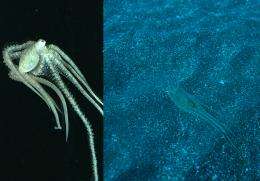A convincing mimic: Scientists report octopus imitating flounder in the Atlantic (w/ Video)

(PhysOrg.com) -- On the open sand plains of the Caribbean seafloor, where soft-bodied animals are routinely exposed to predators, camouflage can be key to survival. Perhaps no group of animals is quite as adept at blending in with its surroundings as cephalopods, who along with relatives the cuttlefish and squid, have evolved a unique skin system that can instantaneously change their appearance.
In the February 2010 issue of The Biological Bulletin, MBL Senior Scientist and cephalopod expert Roger Hanlon and his colleagues report the exceptional camouflage capabilities of the Atlantic longarm octopus, Macrotritopus defilippi, whose strategy for avoiding predators includes expertly disguising itself as a flounder. While Hanlon and others have documented two other species of octopuses imitating flounder in Indonesian waters, this is the first report of flounder mimicry by an Atlantic octopus, and only the fourth convincing case of mimicry for cephalopods.
Comparing still photographs and video footage from five Caribbean locations collected over the last decade, Hanlon and co-authors, MBL graduate students Anya Watson and Alexandra Barbosa, observed uncanny similarities between the small and delicate octopus and the peacock flounder, Bothus lunatus, one of the most common sand dwellers in the Caribbean. They compared not only coloration, which in each animal resembled the sandy seafloor, but swimming speed and form.
Just like flounder, the octopuses contoured their bodies to hug the wavy seafloor, tapering their arms behind them. They also swam with the same fits and starts as flounder at the same speeds. Interestingly, the octopuses mimicked flounder only when swimming, when movement would compromise their camouflage. How well the animals blended in with their background differed. The octopus showed more highly controlled and rapid skin patterning than the flounder, whose camouflage was slower and less precise.
"We were equally impressed with the remarkable camouflage of this small octopus species even when it was stationary yet entirely exposed on top of the open sand," says Hanlon. "The apparent match in pattern, color, brightness, and even 3-dimensional skin texture was noteworthy even when compared to other changeable cephalopods. They also demonstrated an unusual form of disruptive camouflage."
So why do Atlantic longarm octopuses choose to imitate flounder as a way to avoid the threat of predators? More study of cephalopod mimicry is needed, but a possible explanation, according to Hanlon and his team, could be that predators who could easily take a bite out of the small, soft octopus might find a rigid flatfish like the flounder too much of a mouthful and avoid them.
More information: www.biolbull.org/
Provided by Marine Biological Laboratory
















